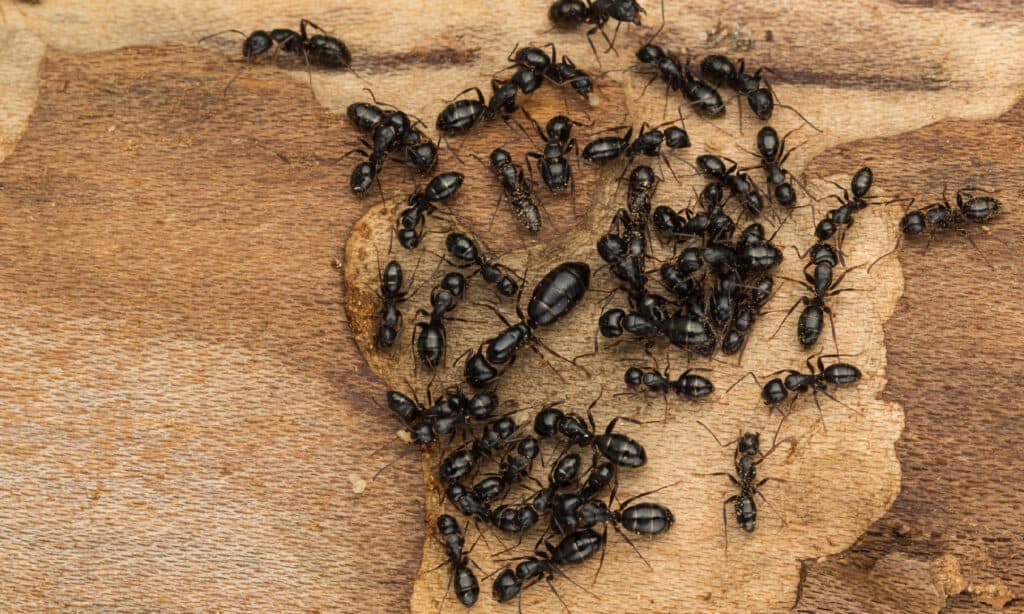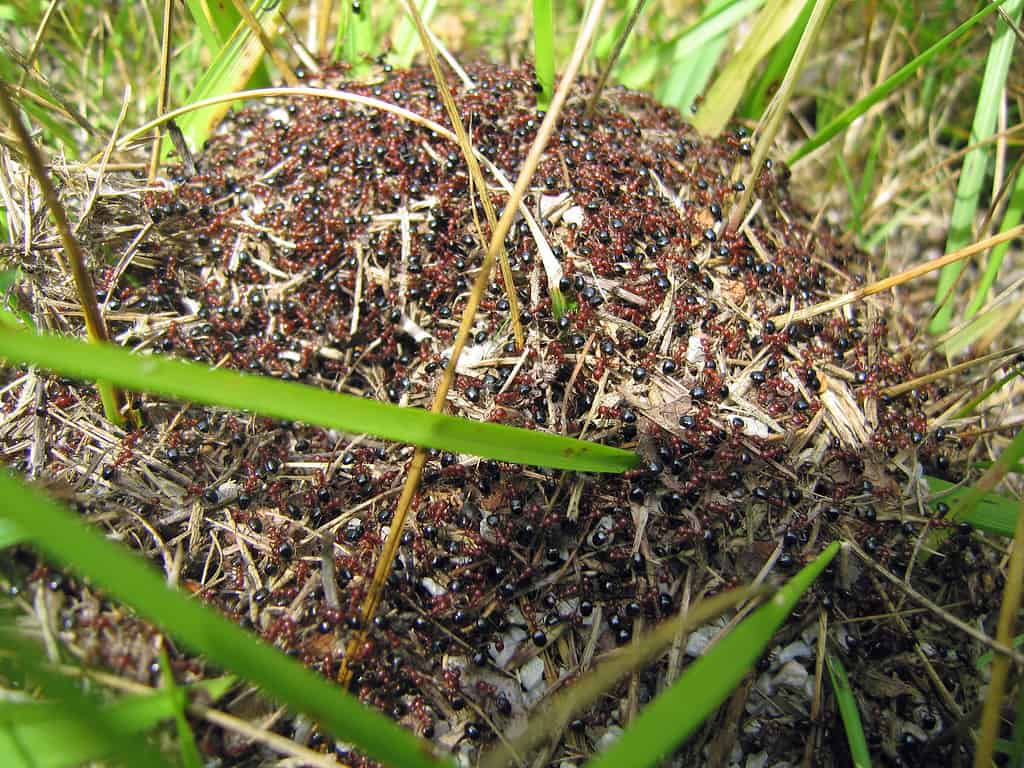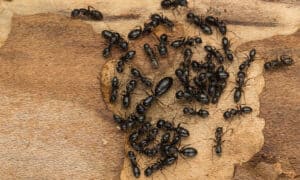Minnesota, known as the Land of 10,000 Lakes, is home to a diverse array of various species of ants. These fascinating insects play essential roles in the ecosystem, contributing to soil aeration, seed dispersal, and the control of other insect populations. In this article, we will explore the types of ants in Minnesota; we will highlight their characteristics, behaviors, and ecological significance. As well as when ants are set to emerge in Minnesota this summer, amongst other insect species, and disappear for the winter.

Ants typically emerge in the spring between March and May.
©Ezume Images/Shutterstock.com
25 Types of Ants Found In Minnesota
It is important to note that ant species’ presence may vary across different regions and habitats within Minnesota. This list represents some common ant species encountered in the state, but additional species exist.
1. American House Ant (Tapinoma sessile)
The American house ant, also known as the odorous house ant, is a common sight of the types of ants in Minnesota. These small ants are typically dark brown to black and emit a distinctive, rotten-coconut odor when crushed. They build their nests in soil, woodpiles, and even within walls of houses. American house ants are omnivorous and feed on various food sources, including sweet substances, dead insects, and plant materials.
2. Pavement Ant (Tetramorium caespitum)
Pavement ants are prevalent in urban and suburban areas of Minnesota. These small, reddish-brown ants derive their name from their habit of nesting under sidewalks, driveways, and pavement cracks. Pavement ants are opportunistic feeders, scavenging on sugary foods, meats, and seeds. They are known for their aggressive behavior and may engage in territorial disputes with neighboring colonies.
3. Thief Ant (Solenopsis molesta)
The thief ant, also called the grease ant, is a tiny, light brown ant species found in Minnesota. Their small size and inconspicuous appearance make them challenging to detect. Thief ants are known for their scavenging behavior, often raiding the nests of other ant species to steal their food resources. They are attracted to fatty or greasy foods and can become a nuisance in homes and kitchens.
4. Carpenter Ant (Camponotus spp.)
Carpenter ants are relatively large ants found across Minnesota. They are typically black or reddish-black and have powerful mandibles for excavating wood. Although they do not eat wood like termites, carpenter ants create extensive galleries within trees and structures, potentially causing structural damage. They primarily feed on other insects and sweet substances, making them an essential part of the ecosystem.
5. Field Ant (Formica spp.)
Field ants are abundant in Minnesota and are known for their large, mounded nests made of soil and plant debris. They play a vital role in aerating the soil and dispersing seeds. Field ants have a varied diet, including honeydew from aphids, nectar from flowers, and dead insects. They are also known to protect their territory and engage in fierce battles with other ant colonies.
6. Thatching Ant (Formica obscuripes)
Thatching ants, a species of field ants, are prevalent in Minnesota’s grasslands and forested areas. They build dome-shaped nests using thatch, a mixture of pine needles, grass, and other organic materials. These nests can reach impressive heights. Thatching ants primarily feed on honeydew from aphids and other insects and play a crucial role in maintaining plant diversity through seed dispersal.
7. Allegheny Mound Ant (Formica exsectoides)
Allegheny mound ants, also known as the mound-building ant, are found in Minnesota’s open grasslands and prairies. These types of ants in Minnesota construct large, earthen mounds that can reach heights of several feet. The mounds provide a stable environment for the colony and regulate temperature and humidity. Allegheny mound ants are generalist feeders, consuming seeds, insects, and other arthropods.
8. Honeypot Ant (Myrmecocystus spp.)
Honeypot ants are fascinating ants known for their ability to store liquid food in their distensible abdomens, which function as living “honey pots.” While found in Minnesota, they are most commonly encountered in arid regions. Honeypot ants are an important food source for other animals and contribute to nutrient cycling.
9. Acrobat Ant (Crematogaster spp.)
Acrobat ants are known for their unique ability to hold their abdomens above their heads when disturbed, appearing acrobatic. These ants nest in decaying wood and forage for various food sources, including dead insects, sweet substances, and seeds. They can sometimes become household pests, seeking food indoors.
10. Velvety Tree Ant (Liometopum spp.)
Velvety tree ants are large, reddish-brown ants that build nests in trees, typically in forested areas. They are known for their mutualistic relationship with aphids, as they tend them for their sweet honeydew secretions. Velvety tree ants regulate aphid populations and can travel in long trails up and down trees
11. Acorn Ant (Temnothorax spp.)
Acorn ants are small and usually nest in acorns, twigs, or tree cavities. These types of ants in Minnesota exhibit various colors depending on the subspecies. However, they are typically light to dark brown. They are highly adaptable and thrive in various habitats, including forests and woodlands. Additionally, they feed on a range of food sources, including nectar, honeydew, and small insects.
12. Red Imported Fire Ant (Solenopsis invicta)
While not native to Minnesota, the red imported fire ant has become invasive in some areas. These ants are reddish-brown and build large, conspicuous mounds. Red imported fire ants are known for their painful stings and aggressive behavior, which can pose risks to humans, pets, and wildlife.
13. Western Thatching Ant (Formica obscuripes occidentalis)
A subspecies of the thatching ant, the western thatching ant, is found in the western parts of Minnesota. They construct large thatch nests and are important for seed dispersal and soil aeration.
14. Large Yellow Ant (Acanthomyops interjectus)
Large yellow ants are medium-sized ants with a yellowish-brown coloration. They are typically found in wooded areas and create nests in soil or decaying wood. These ants primarily feed on insects and honeydew.
15. Citronella Ant (Lasius spp.)
Citronella ants, also known as yellow ants, have a distinctive lemon or citronella-like odor when disturbed. One of the more peculiar types of ants in Minnesota, they prefer nesting in moist environments such as rotting logs or damp soil. Citronella ants feed on honeydew produced by sap-sucking insects.
16. Reddish Brown Stump Ant (Tetramorium immigrants)
Reddish-brown stump ants are small ants with reddish-brown coloration. They build nests in decaying wood, stumps, or logs. These ants are omnivorous and feed on dead insects, seeds, and plant materials.
17. Western Honey Ant (Prenolepis imparis)
Western honey ants, known as winter ants, are found in Minnesota’s northern regions. They have a reddish-brown coloration and store liquid food in their swollen abdomens. Western honey ants are important for nutrient cycling in the ecosystem.
18. European Fire Ant (Myrmica rubra)
The European fire ant is an introduced species in Minnesota and is an invasive pest. They form large colonies and create mounds in open areas. European fire ants can deliver painful stings when disturbed.
19. Pyramid Ant (Dorymyrmex spp.)
Pyramid ants are small to medium-sized ants found in sandy habitats. They are generally known for their reddish-brown to reddish-orange coloration. The workers of pyramid ants typically exhibit this color, while the queens may have slightly different coloration. They construct distinctive pyramidal nests and feed on seeds, insects, and nectar. These ants are known for their aggressive defense of their nests.
20. Little Black Ant (Monomorium minimum)
Little black ants are small, shiny black ants. One of many types of ants in Minnesota, they nest in various locations, including soil, decaying wood, and indoors. These ants are scavengers and feed on a wide range of food sources.
21. Slender Twig Ant (Pseudomyrmex gracilis)
Slender twig ants are slender-bodied ants typically found in wooded areas. They nest in twigs and branches and are known for their aggressive nature. These ants are omnivorous and feed on nectar, insects, and plant secretions.
22. Odorous Field Ant (Formica odorata)
Odorous field ants are medium-sized ants that emit a strong, rotten-coconut odor when crushed, similar to the American house ant. Most often found in open fields and grasslands, these ants feed on honeydew, nectar, and dead insects.
23. Silver Ant (Formica argentea)
The silver ant, also known as the silky ant, is a large ant found in Minnesota. They are known for their silver-gray coloration, which gives them a striking appearance. Silver ants build nests in the soil and create small mounds. They primarily feed on honeydew produced by sap-sucking insects and also scavenge for dead insects.
24. Glossy Ant (Hypoponera opacior)
The glossy ant is a species of small types of ants found in Minnesota. These ants are typically dark brown or black with a shiny appearance. They nest in various locations, including leaf litter, soil, and decaying wood. Glossy ants are omnivorous and feed on various food sources, including insects, plant secretions, and scavenged resources.
25. Harvester Ant (Pogonomyrmex spp.)
Harvester ants reside in open areas such as Minnesota’s prairies, meadows, and sandy habitats. They build large and conspicuous nests with granular soil. Harvester ants have strong mandibles and primarily feed on seeds, which they collect and store in chambers within their nests.

Carpenter ants are one of the most common ants in Minnesota.
©iStock.com/DianaLynne
The Ecological Importance of Ants
There are many types of ants in Minnesota, each with unique characteristics and ecological roles. From the industrious American house ant to the territorial pavement ant and the resourceful thief ant, these insects play vital roles in maintaining the balance of Minnesota’s ecosystems.
The carpenter ant, although sometimes considered a pest due to its ability to damage wooden structures, contributes to the decomposition of dead wood and helps control other insect populations. Field ants, including the thatching ant and Allegheny mound ant, actively participate in soil aeration, seed dispersal, and plant diversity maintenance.
Understanding the various ant species in Minnesota is crucial for promoting coexistence and managing any potential issues that may arise. While some ants may become pests when they invade homes or disturb garden areas, it is important to remember that these creatures have an important place in the natural world.
By respecting their habitats and taking appropriate measures to deter or relocate them when necessary, we can maintain a harmonious relationship with these fascinating insects while preserving the balance of Minnesota’s ecosystems.

Ants are an important part of the ecosystem.
©Ernie Cooper/Shutterstock.com
Ant Emergence in Minnesota
Ants, those industrious and fascinating insects, have distinct seasonal patterns of emergence and activity. Understanding when ants emerge in Minnesota can provide insights into their life cycles and behavior.
Several factors influence their emergence, including temperature, moisture levels, and resource availability. Generally, types of ants in Minnesota start to emerge in the spring months and remain active through the summer and fall before becoming less active in the winter.
Let’s explore the typical months when ants emerge in Minnesota, the factors influencing their emergence, and when their activity levels wind down for winter.
Spring (March to May)
As temperatures rise and winter gives way to spring, ants in Minnesota begin to emerge from their overwintering sites. The exact timing can vary depending on weather conditions. However, generally, ant activity starts to pick up in March and continues through May. During this time, ants maintain focus on building and expanding their colonies, foraging for food, and reproducing.
Summer (June to August)
The summer months are typically the peak season for ant activity in Minnesota. As temperatures become warmer and more consistent, ants are highly active during this period. They engage in foraging expeditions to gather food resources, tend to aphids for honeydew, and defend their territories from rival colonies. Summer is also when many ant species produce new reproductive individuals, known as alates, who participate in nuptial flights to establish new colonies.
Fall (September to November)
As temperatures gradually cool down in the fall, the many types of ants in Minnesota continue their activities. However, they may start preparing for the upcoming winter. This period focuses on storing food reserves and ensuring the survival of the colony during the colder months. Ants may also exhibit increased aggression as they defend their resources against other colonies. As winter approaches, ant activity begins to decline.
Winter (December to February)
During the winter months in Minnesota, ant activity significantly decreases. The cold temperatures and lack of available resources lead ants to enter a period of reduced metabolic activity. Most ants retreat to their underground nests or seek shelter in protected locations, such as tree trunks or inside buildings. They form tight clusters to conserve energy and rely on stored food reserves to sustain the colony until the arrival of more favorable conditions.

Ants and other insects share similar emergence patterns.
©Dhe Tong/Shutterstock.com
3 Factors Influencing Ant Emergence
Three important factors contribute to the emergence of the types of ants in Minnesota each year.
1. Temperature
Temperature plays a crucial role in ant emergence. In Minnesota, ants are ectothermic organisms, meaning environmental temperatures influence their activity levels. As temperatures rise in the spring, ants become more active and initiate their foraging, nest-building, and reproductive behaviors. The warm summer months provide optimal conditions for high ant activity. However, as temperatures drop in the fall and winter, ants enter a reduced activity or dormancy period.
2. Moisture Levels
Moisture availability also affects ant emergence. Adequate moisture is necessary for ants to survive, build nests, and forage for food. Spring often brings increased moisture levels in the form of rain or snowmelt, providing favorable conditions for ants to emerge and establish their colonies. Ant activity may decrease during dry periods, and ants may retreat deeper into their nests to conserve moisture.
3. Resource Availability
The availability of food resources is another crucial factor influencing ant emergence. As temperatures increase in the spring and summer, plants bloom, providing abundant sources of nectar, honeydew, and small insects. This availability of food resources stimulates ant foraging activity and colony growth. Conversely, as resources become scarce in the fall and winter and activity decreases, colonies focus on conserving existing resources.

Allegheny ants construct large mounds that are incredibly complex.
©Allegheny Mound Ants, Formica exsectoides – License
7 Other Common Insects That Emerge Alongside Ants
Of the many types of ants that emerge in Minnesota, they share the season with many other insects, each with unique characteristics and ecological roles. Understanding the diverse array of insects that emerge during the same time as ants in Minnesota enhances our appreciation for the intricate interconnectedness of the ecosystem. These insects collectively contribute to pollination, nutrient cycling, pest control, and the overall balance of the natural environment.
1. Bees
Bees are vital pollinators that emerge during the same period as ants in Minnesota. As temperatures rise, bees become active, visiting flowers to collect nectar and pollen. They play a crucial role in plant reproduction, contributing to the diversity and abundance of flowering plants in the ecosystem.
2. Butterflies
Butterflies are iconic insects that transform from caterpillars to winged beauties. In Minnesota, species such as the Monarch butterfly emerge during the ant emergence season. These colorful insects engage in nectar-feeding, while their caterpillars rely on specific host plants for food and habitat.
3. Dragonflies and Damselflies
Dragonflies and damselflies are agile aerial predators that emerge during the warm months in Minnesota. These insects are excellent flyers and contribute to controlling populations of other flying insects, including mosquitoes. Their diverse colors and intricate wing patterns make them a joy to observe.
4. Grasshoppers and Crickets
Grasshoppers and crickets are known for their distinctive sounds and jumping abilities. They emerge during the same period as ants and play important roles in the ecosystem. Grasshoppers are herbivorous, feeding on vegetation, while crickets are known for their characteristic chirping, attracting mates during the mating season.
5. Beetles
Beetles are a diverse group of insects with various ecological roles. Many beetle species emerge during the ant emergence season in Minnesota. They occupy a wide range of habitats and display various behaviors and adaptations. Some beetles, such as ladybugs, are beneficial predators that feed on aphids and other plant pests.
6. Moths
Moths, overshadowed by their butterfly counterparts, are equally fascinating insects. They emerge during the same period as ants in Minnesota and are important pollinators, contributing to the nighttime ecosystem. Moths exhibit a wide range of sizes, colors, and patterns, making them a diverse group of insects.
7. Mosquitoes
Unfortunately, along with the emergence of beneficial insects, mosquitoes also become more active during the warmer months in Minnesota. These blood-feeding insects can be a nuisance to humans and animals. However, they also serve as a food source for other organisms, contributing to the local food web.

Many ants participate in soil aeration, seed dispersal, and plant diversity maintenance.
©Wirestock Creators/Shutterstock.com
In Conclusion
Many different types of ants reside in Minnesota. Alongside many other species of insects, an emergence every year follows a seasonal pattern influenced by temperature, moisture levels, and resource availability.
Spring marks the beginning of ant activity, as they emerge from overwintering sites to build colonies and forage for food. The summer months bring peak ant activity, with foraging, colony expansion, and reproductive behaviors taking place. As temperatures cool in the fall, ants prepare for winter by storing food reserves and exhibiting defensive behaviors. During the winter, ant activity significantly decreases, and ants enter a period of reduced metabolic activity, seeking shelter in underground nests or protected locations.
Understanding the timing of ant emergence in Minnesota is essential for researchers and individuals managing ant-related issues. Awareness of seasonal patterns makes it possible to predict and plan for ant activity, such as implementing pest control strategies or protecting valuable resources. Studying ant emergence patterns can also contribute to a deeper understanding of their ecological roles and interactions within the local ecosystems.
It is important to note that while general patterns of ant emergence exist, specific timing can vary based on local conditions and the particular ant species in question. Therefore, further research and observations specific to the region can provide more detailed insights into Minnesota’s emergence patterns of different ant species.
The photo featured at the top of this post is © Ezume Images/Shutterstock.com
Thank you for reading! Have some feedback for us? Contact the AZ Animals editorial team.






